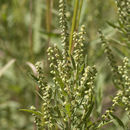More info for the terms:
codominant,
forb,
forbs,
grassland,
heath,
shrub,
shrubsCuman ragweed grows in grasslands, savannas, and woodlands across
North America. In addition to occurring in its native settings (such as
dry prairies, blowouts, washouts, sandy woods, meadows, and hills),
Cuman ragweed is a widespread weed in waste places, roadsides,
railroads, overgrazed rangeland, and other disturbed places
[
41,
75,
99,
107,
126].
Climate ranges from continental to coastal with short, warm to hot
summers and long, cold winters [
1,
3,
16,
129]. Often, there are
moderately strong surface winds [
1]. Humidity is semiarid to moist
subhumid [
42,
44,
86]. Annual precipitation ranges from 5 to 34 inches
(114-880 mm) with 60 to 80 percent occurring during the growing season
[
19,
23,
39,
56,
75,
114,
125]. Temperatures vary from an average 72 degrees
Fahrenheit (22 deg C) in July to a January average of 11 degrees
Fahrenheit (-11.5 deg C) [
124].
Cuman ragweed grows at elevations ranging from 850 to 7,400 feet
(259-2,256 m) and in many types of soils [
18,
30,
60,
66,
69]. Soil
textures are predominantly loams, varying from silty clay loams to fine
sandy loams [
23,
61,
122]. Soil pH ranges from 5.7 to 7.9 [
22,
105].
Soils often have little organic matter and are low in fertility [
34].
Cuman ragweed occurs in too many grassland ecosystems for associated
species to be reviewed here. Listed below are some typical examples of
major grasslands and the plant components found with Cuman ragweed.
In addition to this brief listing, the reader is referred to specific
examples of more distinct and diverse grasslands in which western
ragweed occurs [11,15,18,19,20,22,25,26,28,29,32,33,39,42,49,129].
Southern Great Plains
Shortgrass prairie is dominated by buffalo grass (Buchloe dactyloides)
and blue grama (Bouteloua gracilis) with sand dropseed (Sporobolus
cryptandrus [
132]. When trees occur, sand shinnery oak (Quercus
havardii) is dominant [
45,
118].
Mixed-grass prairie is dominated by sideoats grama (Bouteloua
curtipendula), buffalo grass, little bluestem, and tobosagrass (Hilaria
mutica) [
132]. When an overstory is present, dominant trees are honey
mesquite (Prosopis glandulifera), Ashe juniper (Juniperus ashei), post
oak (Quercus stellata), blackjack oak (Q. marilandica), and live oak (Q.
virginiana) [
59,
67,
86,
112]. Shrubs include cholla (Opuntia imbricata),
common broomweed (Xanthocephalum dracunculoides), and whitebrush
(Aloysia lycoiodes) [
47,
66,
123]. An associated forb is Riddel daisy
(Aphanostephus riddellii) [
47,
65].
Tallgrass prairie is dominated by little bluestem, silver bluestem
(Andropogon saccharoides), and fewflowered panic (Dicanthelium
oligosanthes) [
36].
Central Great Plains Shortgrass dominated by blue grama with
buffalograss, sand reedgrass (Calamovilfa longifolia), and prairie
dropseed (Sporobolus heterolepis) [
82,
122,
132]. An associated forb is
horseweed (Conyza canadensis) [
43].
Northern Great Plains Tallgrass prairie is dominated by big bluestem
with little bluestem, Indiangrass (Sorghastrum nutans), and switchgrass
(Panicum virgatum) [
132]. A shrub co-occurring with Cuman ragweed is
Louisiana sandwort (Artemisia ludoviciana) [
120]. Codominant forbs are
heath aster (Aster ericoides), purple prairie-clover (Petalostemum
purpureum), and goldenrods (Solidago spp.) [
1,
35,
106,
120].
Cuman ragweed occurs on floodplain woodlands with sand reedgrass and
Canadian wildrye (Elymus canadensis) [
4,
117]. The overstory is
dominated by floodplain cottonwood (Populus deltoides) with green ash
(Fraxinus pennsylvanica) [
117].

